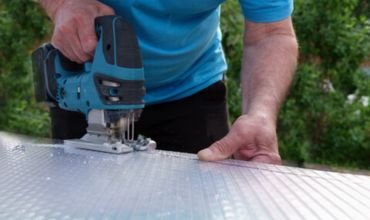Ceiling make up your house in every way, whether adding value to your property or ensuring its safety. But using suitable materials makes the rooftops reliable and secure, and polycarbonate sheets are a good option. They are best known for their strength, lastingness, and versatility, which has made them a preferred choice amongst the proprietors. So, are you planning to install a polycarbonate rooftop with its sheets but do not know how to cut corrugated polycarbonate roof panel? Then, this segment is meant for you to gain accurate info about cutting the sheets effectively and safely.

Before you begin, read here to learn more about polycarbonate sheets to avoid the hassles while you cut the panels. Polycarbonate is typically a lightweight element yet a solid plastic with great longevity. While exploring for an undestroyable, water-resistant, and crushproof rooftop material, polycarbonate sheets will be your best choice. They are ideal for roofing applications, greenhouse boards, and protective barriers, as this material provides UV protection.
Appropriately cutting down the polycarbonate ceiling panels is vital to ensure a long-lasting fit for your ceiling installation. You can read further to explore how to cut corrugated polycarbonate roof panels using the tools and pieces of equipment. This will help you to achieve a clean and accurate cutting for your requirements. It goes as!
While you cut a polycarbonate panel, stick to the following method:

Note: To reduce the uneven breaks and obtain straight cuts, repeat the scoring process more than once to grove deeper before snapping.
To cut your polycarbonate sheets with the fine-toothed circular saw, you should follow the following steps:
Tips: It is essential to maintain a moderate speed to prevent the melting of the material caused due to the frictional heat. Also, you can use masking tape over the cut lines for minimal chipping.
You can cut the polycarbonate boards with a band saw by:

Tips: Note that a sow feed rate would reduce the risk of jagged vertices. The band saw effectively cuts thicket materials and complex patterns due to its precision.
A fine-toothed blade jig-saw can also be used for cutting the polycarbonate roofing panels by:
Caution: To get a perfect shape, you can pause to cool down the blade and control the jigsaw to avoid cracks and damage.
The Dremel with a cutting wheel helps make quick adjustments and detail the polycarbonate sheet. To use it, follow the below-noted steps:

To begin with the polycarbonate roofing panels, you should start by finding the correct proportion spacing for the installation. Indeed, this is one of the most critical factors for effective fits and appropriate ceiling insulations. Additionally, you should consider the other aspects, including exposure, location, sheet thickness, and structural requirements. You can calculate the spacing using the following formula:
| Sheet Width= Rafter Spacing- (1 * Expansion gap) |
Account for expansion gaps between every rafter to manage the glazing bars; the fasteners would vary by type. Consider the Snap Fix Glazing Bars that require more than the Self-supported Glazing Bars and Aluminum Bars. While placing an order for pre-cuts, you should ensure that an additional adjustment width offers accurate trims without moving the rafters.

Apart from this, here are some of the top precautions you should take while cutting down the panels. To reduce the risks, follow the below-mentioned measures:

By now, you must have got your answer to how to cut polycarbonate corrugated roof panel. Indeed, the procedure is not time-consuming and requires minimal effort. Polycarbonate is an excellent ceiling material for you if you are a DIY person due to its minimum weight and ease of handling. You can ideally cut out the board into required sheets without any difficulty. But yes, it is essential to stick with adequate planning, follow precautions, and use the right equipment. Hence, you can cut down the boards and install a fresh ceiling by keeping everything perfect.
The roofing experts suggest that a jig saw is the best way to cut the winkled polycarbonate panels into extravagant shapes. This tool offers a sharp metal cutting blade that works with an efficiency of 12000 strokes per minute.
To cut a polycarbonate board, use power tools like a circular or jig saw. But while doing so, make sure you are cautious, as even a minute mistake can ruin your sheet.
Use a circular saw to the required pieces to cut down a more extended polycarbonate sheet effectively. You can use masking tape to mark cutting lines for precise cuts.
Use a fine-toothed blade to cut down a polycarbonated panel while slowly pushing down the sheet without putting any additional pressure on it.
You can cut down the panels with scissors if the sheet is thin. First, lay the sheet over a flat surface and mark the cuts using masking tape.
You can buy polycarbonate panels according to your required finish, dimensions, and thickness with minimal wastage at an affordable price.
Leave a Reply